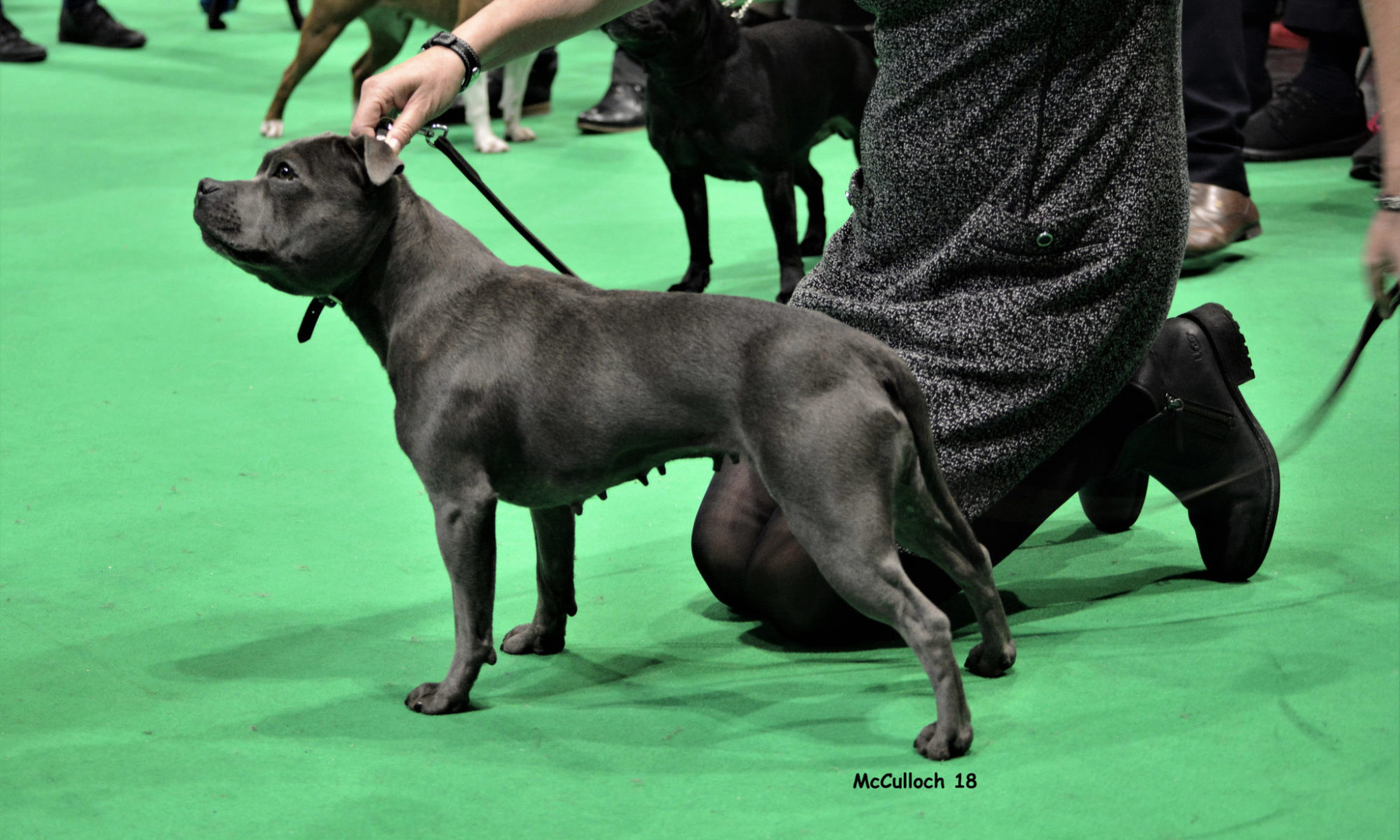*IMPORTANT*When you decide where you want to get your next Staffordshire Bull Terrier PLEASE ask to see the certificates for health testing for L2-HGA (L-2-hydroxyglutaric acid) and HC (Hereditary Cataracts). Both tests can now be done by DNA testing and all Staffords used for breeding should be tested. Don’t just believe the words “Health Tested” or “Clear for L2” from a website – see the certificates for yourself to be sure! Some breeders are saying their dogs have been tested in order to sell puppies but unless it can be proven, don’t believe it. Another thing, if a breeder tells you “it doesn’t run in my lines” – run. dont believe that either. If they are not testing they cannot be certain! ?What you want to see is that they are ‘clear’ or ‘normal’ for L2-HGA and HC and “Fair, Good or Excellent” for OFA hips, “Normal” OFA patella. Some breeders also test cardiac, elbows, CERF eyes. Not all do those tests but be sure you buy a pup who is ‘clear’ – ‘normal’ for L2-HGA and HC & PHPV.
“When strong habits impede our ability to acquire a desired new habit or association, we experience a common phenomenon known as proactive interference whereas old memories inhibit the learning of new memories”
L-2-HYDROXYGLUTARIC ACIDURIA (L-2-HGA): L-2-HGA is a metabolic condition of Staffordshire Bull Terriers in which affected dogs lack an enzyme to properly break down a metabolic byproduct, an organic acid, L-2-hydroxyglutaric acid. This compound then builds up in the cerebrospinal fluid and plasma of the affected dogs, causing the symptoms of this illness. Central nervous system symptoms include lack of coordination, tremors, personality disorders, poor learning abilities, and seizures. These affected dogs usually excrete high levels of the compound in their urine, hence the term “aciduria”. Unfortunately, treatment is entirely symptomatic; there is no cure. Affected dogs often must be euthanized at an early age, and even the more mildly affected will never behave like a “normal dog.” L-2-HGA is now known to be transmitted by means of an autosomal recessive mode of inheritance. A simple DNA test, using a small sample of the dog’s saliva, is now available which will identify carriers, clears, and affecteds for this condition in the Staffordshire Bull Terrier. A dog who is a carrier has one copy of the mutated gene, but does not itself show signs of the disease. The affected dog has both mutated copies of the gene and develops L-2-HGA, while the clear dog has two normal genes. A carrier, if bred to another carrier, will produce on average one affected puppy, two carriers, and one clear puppy for every four puppies produced. However, by using the new DNA test, breeders can test their breeding stock, and, based upon this test, breed appropriately to prevent affected puppies from being produced. It is critical that all breeders use this new DNA test to screen their breeding stock for this mutation, since it is estimated (late 2006) that upwards of 15% of the Staffords in the U.S. are carriers.
HEREDITARY (JUVENILE) CATARACT (HC): Hereditary cataract is a hereditary condition that causes an opacity or cloudiness to develop in the lens of a dog’s eyes at a relatively early age. Although the eyes are normal at birth, bilateral cataracts form usually by several months of age. This condition often progresses rapidly, leading to total blindness by three years of age. Surgery (canine lens extraction using phacoemulsification) can be used to restore sight to the affected dog; however, it has only a 75% long term success rate in restoring useful vision. Hereditary cataract is now known to be transmitted by means of an autosomal recessive mode of inheritance. A simple DNA test, using a small sample of the dog’s blood, is now available which will identify carriers, clears, and affecteds for this condition in the Staffordshire Bull Terrier. A dog who is a carrier has one copy of the mutated gene, but does not itself show signs of the disease. The affected dog has both mutated copies of the gene and develops cataracts, while the clear dog has two normal genes. A carrier, if bred to another carrier, will produce on average one affected puppy, two carriers, and one clear puppy for every four puppies produced. By using the new DNA test, breeders can test their breeding stock, and, based upon this test, breed appropriately to prevent affected puppies from being produced. With limited testing in the U.S. approximately 8% of all U.S. Staffords tested for Hereditary Cataract have been shown to be carriers.
PERSITENT HYPERPLASTIC PRIMARY VITREOUS – PHPV – The mode of inheritance of PHPV is not so clear, but it is known that it is a congenital condition (present at birth) and that it is not progressive. This means that if a puppy is born with PHPV it can be detected by ophthalmic screening from 6 weeks of age and if it is affected, whatever the condition of the problem at that stage it will not change throughout the dogs life.Either of the above conditions (HC and PHPV) can be operated on, but it is a serious operation and can be traumatic and very expensive. It is not always covered by insurance due to the hereditary nature.Even though the genetic test is now available for Hereditary Cataracts it is still important to screen for PHPV. It is recommended that litters are screened – the result will enable puppy buyers the knowledge that their puppy is unaffected by PHPV and in the worst event that an affected puppy is detected the breeder can arrange for the entire litter to submit DNA samples to further the research in to
PHPV.POSTERIOR POLAR SUBCAPSULAR CATARACT – PPSC – This type of cataract is found in other breeds, particularly the Labrador and Golden Retriever. It usually remains as a small, punctuate cataract and doesn’t usually lead to sight problems in these two breeds. It has been placed on schedule 3 of the BVA/KC/ISDS Eye Scheme because a number of Staffords that have been through the Scheme have been found to have this type of cataract. This type of cataract cannot be detected through litter screening. The mode of inheritance is unknown and it has a variable age of onset. IT IS RECOMMENDED THAT BREEDING STOCK SHOULD BE TESTED PRIOR TO MATING TO DETERMINE THAT THE DOG IS CERTIFIED UNAFFECTED AT THE TIME OF MATING
HEAT STROKE: Many of you know we do a lot of sports with our Staffords. I cannot stress enough the importance of taking all precautions against overheating with this breed. They tend to get very exited and cannot control this which can easily lead to heat stroke. I have witnessed it many times in the breed. Never leave them in a position where they can see or hear the sport but not be involved. They cannot understand how to wait their turn calmly. We take extra precautions year round no matter hot, cold, rain or humid – we take cool coats, crate fans, alcohol wipes or sprays, plenty of water, and shade cloths. We set up out of sight of the pool or lure course and cover crates which face the other direction. If the dog is getting too worked up we move them even further and distract them. Staffords can and will overheat. Its a fact.
HIP DYSPLASIA: Hip dysplasia is a crippling condition in which laxness in the hip joint causes premature breakdown of the cartilage lining, leading to arthritis. The tendency to hip dysplasia can be passed on from one generation to the next; researchers believe that it is a polygenic-based disorder, having more than one causative gene. Symptoms may include difficulty jumping or using stairs; unusual stiffness after exercise; and a peculiar “bunny-hopping” gait. While there is a strong hereditary component to this affliction, many believe environmental factors, such as overfeeding leading to too-rapid growth in puppies, can cause the condition to progress much more rapidly if a genetic tendency is already present. Often, the effects of mild hip dysplasia are not seen until the dog is middle-age or older, and can be managed by weight control and anti-inflammatory medications. Occasionally, however, puppies and young dogs can show symptoms of hip dysplasia which are rapidly progressive and crippling; special surgical techniques have been developed for these dogs to help them lead a more normal and pain-free life. According to the latest OFA statistics (2006), with 379 Staffords having been evaluated using hip x-rays, 16.2% are rated abnormal (dysplastic), and 80.2% have both hips graded normal. Since this is at least partially a hereditary condition, careful breeding will reduce its incidence in a breed over time. If both parents have normal hips, there is a lessened possibility for one or more puppies in a litter to be later rated dysplastic.
ELBOW DYSPLASIA: The term elbow dysplasia is used to describe a degenerative disorder of the elbow joint caused by improper development of a portion of a particular bone in this joint (anconeal process of the ulna). Young dogs that have this condition often exhibit pain when jumping or turning quickly, or may show variable foreleg lameness. It is thought to be hereditary in nature, and tends to run in canine families. However, exogenous causes, such as over feeing a puppy into too-rapid growth, may be partially to blame as well, especially if a genetic tendency is present. Injury to the joint might also be a cause. Depending upon the age of the dog, the actual cause, and the severity of the symptoms, treatment can include modalities ranging from anti-inflammatories medications up to surgery. According to the latest OFA statistics (2006), with 105 Staffords having been evaluated using elbow x-rays, 14.3% of these Staffords have elbow dysplasia, while 84.8% are rated as having normal elbows.
PATELLAR LUXATION: Patellar luxation is a condition in which the patella, or kneecap, of the dog’s stifle joint frequently luxates or “pops” out of place. Depending upon the severity, symptoms can be intermittent and mild throughout the dog’s life, with the only evidence of the condition an occasional funny “kick” of the dog’s hind leg, or it may eventually lead to severe, permanent degenerative changes in the joint including arthritis. Infrequently, onset may appear to be sudden, leaving the dog unable to stand on the affected hindleg(s). Patellar luxation is believed to be hereditary, as well, although the exact mode of transmission is uncertain. According to the latest OFA statistics (2006), with 21 Staffords having been evaluated radiographically (using x-rays), 100% were evaluated as “normal.” However, these statistics are considered misleading, not only because of the small sample size evaluated, but also because patellar luxation is known for certain to occasionally be found in this breed.
ATOPIC DERMATITIS (SKIN ALLERGY): Certain Staffords are prone to various skin allergies, causing them to bite, scratch, and lick their itchy places continually until the source of the problem is corrected by the owner or their vet. An afflicted dog may lose huge patches of hair or develop large “lick sores” in the process. Secondary infections may then occur in the raw, exposed skin. A “flea bite allergy” often plays a considerable role in this condition; aggressive “flea control” measures (both on the dog and in the premises where the dog resides) throughout the year will often by itself ameliorate this condition in milder cases. Contact allergies to pollens, dusts, molds, and other environmental allergens may be to blame. (One indoor allergen responsible for much atopic dermatitis in dogs, the feces of the ubiquitous house dust mite, is a major allergen for humans, as well.) Less frequently, food intolerances may play a role, and the dog must be relegated by the veterinarian to a strict dietary protocol. For milder cases, some dog owners and vets have seen improvement using fish oil supplements; the omega-3 fatty acids contained in fish oils act as a natural anti-inflammatory and help to relieve the itching. Severe cases of atopic dermatitis can be difficult to manage, and the advice and help of a veterinarian are needed to bring the afflicted dog relief. Often treatment to control the itching (such as antihistamines or even prednisone), identification and removal of the source of the allergen from the dog’s environment, and treatment of the secondary skin infections are all necessary in order to control the condition in especially severe cases. While no studies have been done specifically on Staffords, research with dogs in general show this condition to have, at least in part, a genetic mode of transmission. *NOTE* Wavemaker Staffords does NOT practice nor condone the use of antibiotics, steroids or other traditional treatments for ‘allergies’. By taking the dog off of all poisons/vaccines, switching to a species appropriate diet and promoting the dogs own immune system, we feel strongly that these so called ‘allergic reactions’ will go away. There are affective natural methods for treating raw skin, itching and licking.
DEMODECTIC MANGE (DEMODICOSIS): Demodicosis is a skin condition caused by the tiny mite Demodex canis. Nearly all dogs carry this tiny skin parasite, but most adult dogs’ immune systems are able to keep the mite in check, and no symptoms are observed. (Even most humans carry this mite in limited numbers in their skin!) Frequently in puppyhood and adolescence (4 months to 18 months of age is most typical), puppies of many breeds (including Staffords) may develop a few quarter-sized bald patches on their face and chest; these usually resolve in time without treatment. Unfortunately, certain dogs are not so lucky; the condition becomes generalized and wide-spread over the entire body. “………………” Certain lines of Staffords appear to be particularly prone to generalized demodicosis. Whether or not a Stafford with generalized demodicosis should be used in a breeding program is a controversial subject at the moment, however, the tendency towards the condition is thought be many to be an inherited one.
BRACHYCEPHALIC SYNDROME – Brachycephalic syndrome is present in all breeds with a shortened upper jaw giving a “squished” look to the dog’s face, including Pugs, Bulldogs and Staffordshire Bull Terriers, among others. This is not a single disease or condition. Rather, it is a grouping of conditions and symptoms that are commonly seen in certain breeds. These conditions include elongated soft palate, stenotic nares and everted laryngeal saccules. A collapsing trachea may also be seen in dogs with brachycephalic syndrome. Symptoms include difficulty breathing and white, foamy vomit after eating. Surgery can correct brachycephalic syndrome in most cases.
All Wavemaker pups to be sold on contract to pre-approved homes only. Expect to wait a while if approved. Local to S.E., no/low vax, raw fed homes preferred. Must collect pup in person. No shipping.
We do not breed for color. Please do not ask for a blue puppy. We do not breed often therefore we will probably refer you to reputable breeders who health test whom we trust.
Copyright 2003-2021 by Wavemaker Staffords. WARNING ! All content contained within this site is protected by copyright laws. Unauthorized use of our material is strictly prohibited. Please ask for permission if interested in usage.
Play nice, we share.


